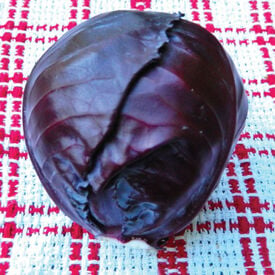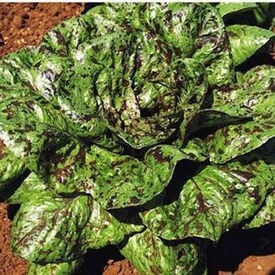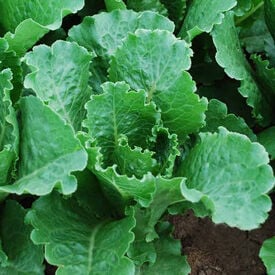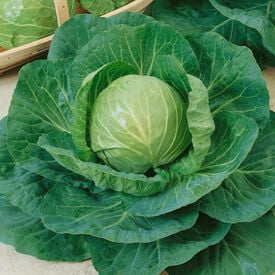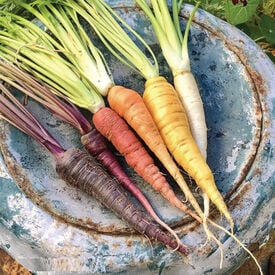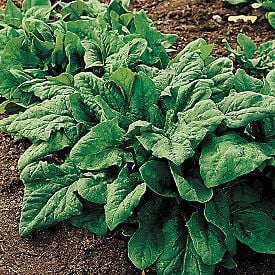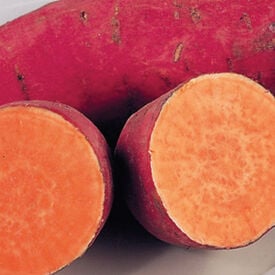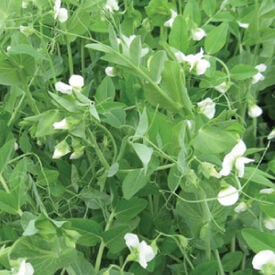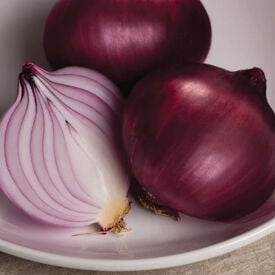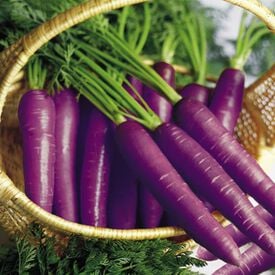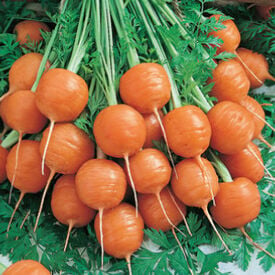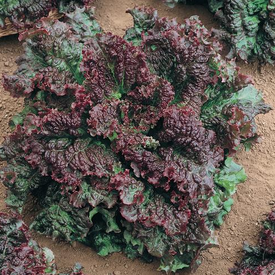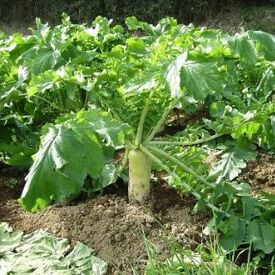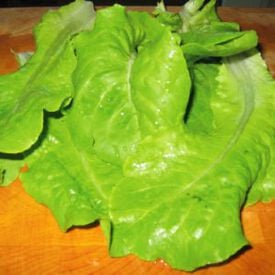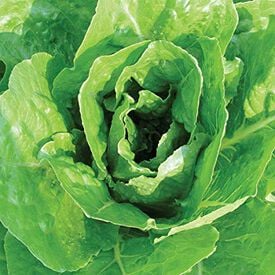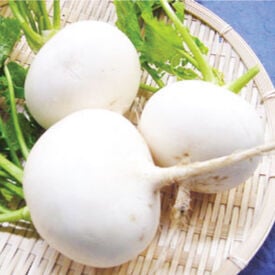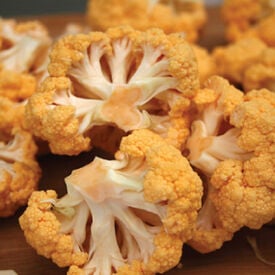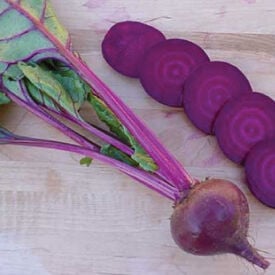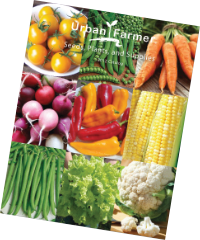Red Acre cabbage is simply the best early maturing red cabbage! Red Acre is a fantastic cabbage that produces reddish-purple heads. Each cabbage head grows to 7 inches in diameter and weighs about 3 pounds. Red Acre is resistant to cabbage yellowing and is great for home gardens that have little space. Red Acre cabbage stores better than just about any other early cabbage variety. Great raw or for coleslaw use.
Freckles Lettuce gets its name for being an unusual bright green romaine lettuce with crimson freckles! This uniquely colored lettuce is sun-loving and grows upright. This variety has a crisp texture that can be harvested early or late!
The Crisp Mint Lettuce is a big romaine variety with mint green-colored leaves that will be sure to stand out in any home garden! This bold lettuce is only mint in color, not taste. However, its sweet and crunchy leaves will be a favorite addition to any salad or sandwich. Crisp Mint's heads will reach 10 inches tall making it perfect for a container garden!
The Green express is a bright green mini cabbage with excellent flavor! This favorite is now available as organic. The early maturing cabbage has a mild flavor and crisp texture that can't be beat. The Green Express can be sown directly in Fall gardens or transplanted in Spring.
The rainbow mix is a blend of our favorite bright heirloom carrots! Mix of every imaginable carrot color, purple, red, white, even some orange. Purple has smooth skin, coreless orange flesh and is sweet and tasty. Yellow holds its sunny hue inside and out, is crunchy, sweet and juicy. White is mild and delicious, and Red has high lycopene levels as well as a crispy texture that is great cooked. Enjoy these delicious carrots cooked or raw.
The super sweet Renegade Spinach is simply the best all-around Spinach! This very adaptable spinach variety is early maturing with heavy yields and is easy to grow. Its dark green, rounded leaves are resistant to mildew and arise profusely on compact plants. Renegade is perfect for beginning gardeners and those that have been let down by other varieties!
Certified - The Beauregard Sweet Potato is one of the most top yielding sweet potatoes available! Beauregard is such an outstanding release that has been accepted by farmers everywhere! Chances are that this sweet potato is the variety that is available in your local market. The red-orange outside color and orange inside color make it an attractive favorite. Beauregard is quick maturing with good shape.
The Austrian Winter Pea, sometimes called black pea or field pea, is a great cool season legume for cover crops, wildlife and winter grazing! This cool-season, annual legume has good, nitrogen-fixing capabilities. The Austrian Winter Pea is a low-growing, viny legume which has been shown to fix over 200 pounds of nitrogen per acre per year. It has hollow, slender and succulent stems, 2 to 4 feet long. The foliage is pale green, and the flowers are colored, usually purple, pink or reddish. Uses: Chicken forage, deer attractant, forage, green manure, nitrogen fixation, no till, organic matter (biomass), weed suppression
Red Rock demonstrates good size with excellent internal dark red color and a good single-center percentage. Red Rock has a very good red scale and produces a nice firm bulb that can be stored for several months. It is also a Celebrate Onion with a good root system and grower friendly structure. Disease Ratings: High Tolerance for Bolting. Good Tolerance to Pink Root and Fusarium.
The Cosmic Purple carrot is absolutely amazing! This beautiful purple carrot is bright yellow and orange inside! Cosmic Purple carrots have a tapered 7" shape and a very sweet taste, that has extra healthy anti-oxidants. This carrot is quite popular at farmers markets.
The Parisian carrot is a little round carrot that is a nineteenth-century French heirloom! this carrot variety is an early orange-red carrot that grows almost more like the shape of a large radish. Excels in clay or rocky soil where other carrots have problems developing properly. Its flavor is legendary and is highly sought after by gourmet restaurants.
The Gabriella is a loose leaf lettuce variety that has beautiful deep wine colored leaves. This variety's purple leaves are frilly and sweet -- perfect for adding a pop of color to salads! The Gabriella's leaves are delicious from mesclun size to maturity. This variety is heat resistant and slow bolting.
The Jackhammer Radish is a fast growing daikon radish variety that is a great scavenger that will start germinating immediately! This variety is very easy to grow. The Jackhammer Radish is good for winter kills and turns into great biomass. Radish (Brassica): Cool Season, broadleaf, Annual, Upright and spreading habit, Root Crop Uses: Nitrogen Scavenger, Green Manure, Forage, Organic Matter, Weed Suppression
Buttercrunch lettuce seeds produce a popular variety known for its crisp, tender leaves and sweet, buttery flavor. This heirloom variety features thick, light green leaves that form a loose, rosette shape, making it visually appealing in the garden and on the plate. Buttercrunch lettuce is known for its ability to tolerate heat better than many other lettuces, which allows for extended growing seasons. The leaves are slightly wavy and have a delicate texture, making them perfect for salads, sandwiches, and wraps. They also hold up well in dressings, adding a delightful crunch. When grown from seed, Buttercrunch lettuce typically germinates quickly, with seedlings developing into lush heads in a relatively short time. It thrives in cooler weather, making it an excellent choice for spring and fall gardens. Overall, Buttercrunch lettuce seeds offer a reliable and delicious option for home gardeners seeking to enjoy fresh, homegrown greens!
The Giant Caesar Lettuce is an amazing bright green looseleaf romaine type that has a buttery sweet flavor similar to a butterhead. This variety's large leaves are easy to pick without any tearing or bruising. The Giant Caesar is heat resistant and will hold its color and flavor well.
The Seven Top is a tender, round and beautiful white globed turnip variety that produces consistently for a long period! This turnip is the best variety for producing masses of fine-flavored, old-fashioned, turnip greens that makes the ultimate southern staple!
The Cheddar cauliflower lives up to its name with its awesome cheddar color and great flavor! This cauliflower is a novelty, orange curd that is high in beta-carotene. A mid-size plant, domed head, and is very productive in the fall. Fun to watch grow and eat!
The Ruby Queen is an excellent canning and fresh eating beet! A perfectly round beet that has a smooth buttery texture that is more tender than any other beet. An early maturing beet, 52 days, that grows well in any soil type throughout the country. Ruby Queen can be grown close because they hold their shape well. They can also be grown larger than most beets and still hold good flavor making it a great market beet. An All American Selection winner!
